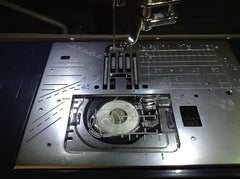Is Feed Dog Up or Down When Using a Walking Foot in Quilting
Do I Have to Drop My Feed Dogs for Free Motion Quilting?
 Feed dogs are the little teeth on your sewing machine that feed your fabric evenly through the machine. These teeth are extremely important because they help us produce perfectly spaced, even stitches whenever we sew garments, piece quilts, or applique shapes on our machine.
Feed dogs are the little teeth on your sewing machine that feed your fabric evenly through the machine. These teeth are extremely important because they help us produce perfectly spaced, even stitches whenever we sew garments, piece quilts, or applique shapes on our machine.
However, there is one time that you don't need your feed dogs - free motion machine quilting.
When free motion quilting, you need to be able to move the quilt smoothly in all directions to fill your quilts with beautiful texture. The feed dogs on your machine can pull against the back side of your quilt, making it more challenging to quilt in all directions smoothly.
For this reason, many quilters have been taught to drop their feed dogs using a lever or button on their machine. Most newer machines have this option to easily drop the feed dogs, but many older machines don't have that capability.
But do you really need to drop your feed dogs?
 When I first began free motion quilting, I was taught to drop my feed dogs. I did this religiously for awhile, then because I was quilting so much and always in a hurry, I began forgetting to do this extra step.
When I first began free motion quilting, I was taught to drop my feed dogs. I did this religiously for awhile, then because I was quilting so much and always in a hurry, I began forgetting to do this extra step.
What I found was surprising - when leaving my feed dogs up, I noticed no difference in the feeling of free motion quilting. I was still able to quilt in all directions smoothly, but when I took a closer look at my stitches, I found they looked much better on both the front and back of the quilt.
So I started paying more attention to what I was doing in my sewing room to see when my stitches looked best. I soon discovered that my machine not only made better stitches with the feed dogs up, I had fewer tension issues, fewer thread breaks, and generally a much more enjoyable quilting experience!
What Also Turns Off with the Feed Dogs
From my experience, I've found that many machines just don't work as well with the feed dogs dropped, or turned off. After speaking with a machine repairman, he explained that the timing of the machine is closely linked to the feed dogs. When the feed dogs are dropped, timing and tension can both be effected.
I've also owned machines that were generally thought to be bad at free motion quilting. When the Janome Horizon 7700 launched, many quilting forums filled with complaints about the tension issues when free motion quilting on this machine. All of these quilters were putting the machine into the "free motion setting" which automatically dropped the feed dogs.
 Meanwhile I was successfully free motion quilting on this machine because I didn't use that setting. Instead I set my stitch length to the lowest setting, which limited the movement of the feed dogs to just bouncing up and down, not feeding against the back of my quilt.
Meanwhile I was successfully free motion quilting on this machine because I didn't use that setting. Instead I set my stitch length to the lowest setting, which limited the movement of the feed dogs to just bouncing up and down, not feeding against the back of my quilt.
I also cover the feed dogs with a Supreme Slider, a slippery sheet that makes it easier to move your quilt smoothly under your needle. The combination of setting the stitch length to the lowest setting and covering the feed dogs with the supreme slider has been the ultimate trick to free motion quilting beautifully with the feed dogs up.
Will Leaving the Feed Dogs Up Damage My Machine?
This is a funny question because what is the normal position for your feed dogs to be in? Feed dogs are meant to be up and engaged so you can sew evenly spaced stitches. This is the way the machine is designed to be used!
But so many quilters have been taught that they MUST drop their feed dogs for free motion quilting that many assume changing this step will somehow be detrimental to their machine. Even more quilters have been convinced that they can't possibly free motion quilt on their older machine simply because it doesn't have the ability to drop the feed dogs.
The truth is, this is an optional step. You can drop your feed dogs or leave them up. It's best to try both methods and see what works best for you on your particular machine.
| Suggested Settings for Free Motion Quilting with Feed Dogs Up | Suggested Settings for Free Motion Quilting with Feed Dogs Down |
| Change stitch length to the lowest setting | Leave stitch length at normal setting |
It's an optional extra step to cover machine bed with a Supreme Slider, which can make your quilt much easier to move smoothly in all directions.
Whenever I mention changing the stitch length, I almost immediately receive the question "What about stitch width?"
Unless you want to zigzag free motion quilt, you don't need to change your stitch width at all. If you adjust this setting, you will begin to zigzag as you free motion quilt!
Learn more about machine quilting on your home machine
Source: https://leahday.com/pages/drop-feed-dogs-free-motion-quilting